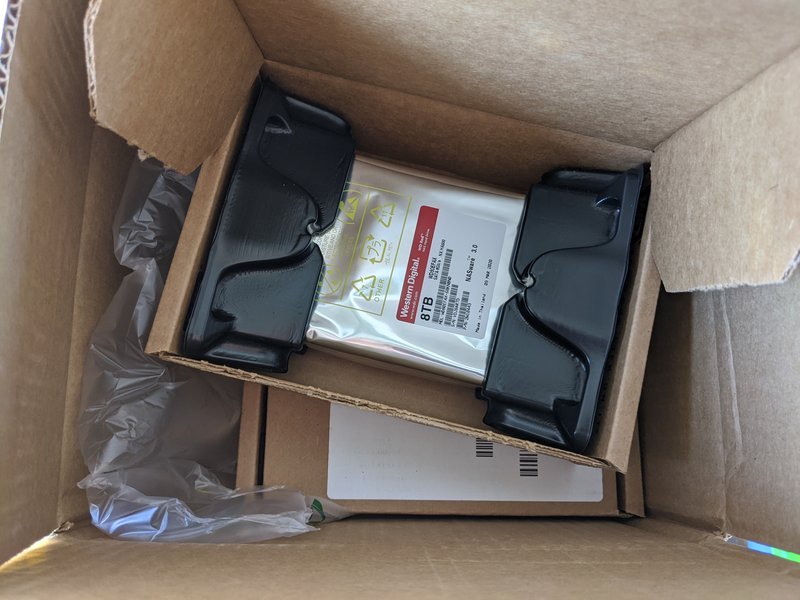In my previous post I talked about my motivation for putting together a NAS setup at home to backup photos.
To continue where we left off, thankfully newegg packaged the HDD appropriately:

After realizing I didn’t have the proper SATA power cables and getting those, I inserted the drives into my machine and set up btrfs.
btrfs is a modern filesystem that ships with the Linux kernel. Btrfs provides some features that you wouldn’t get with ext4:
- Software RAID without additional software (I’m running RAID1 with two 8TB drives)
- Transparent compression (per file or per volume). I think per-file
is the way to go (
chattr +c). - Hashes on filesystem data and metadata. Ability to repair with RAID. I’m using xxhash. Link to hash method comparisons.
- Copy on write (
cp --reflink <source file> <destination file>) - Subvolumes (looks like a subfolder but you can mount it separately)
- Snapshots of subvolumes. If you run btrfs on your root drive, when you set it up, after mkfs.btrfs, you can create subvolumes for your root directory. Then setup Linux on the subvolume. Then it’s easy to take snapshots and switch between snapshots of root.
- Data deduplication (with userspace tools)
The biggest competitor on Linux to btrfs is ZFS (and maybe XFS to some extent). ZFS is not shipped with the Linux kernel so it may be a little more work to set up (depending on your Linux distribution). Ubuntu 20.04 has made it pretty easy if you want to try ZFS.
I compiled the latest btrfs tools and I’m using the latest stable kernel which I compiled myself. It’s recommended to use the latest btrfs code because it’s under pretty active development and if I have to post to a mailing list I’d get better help if I’m using the latest code. Most software developers aren’t as interested in helping people running older versions of their code.
/usr/local/bin/mkfs.btrfs -d raid1 -m raid1 --checksum xxhash -L wdred8 /dev/sdb /dev/sdd
I added the following line to my fstab and mounted the drive (this UUID is unique to my drive, so replace it for yours):
UUID=69d03e6e-55c3-4c52-8602-1100b9db0feb /mnt/backup btrfs rw,relatime,space_cache,subvolid=5,subvol=/ 0 2
I created some subvolumes for photos (if I need to snapshot it):
subvolume create /mnt/backup/photos
...
I installed samba following this
tutorial. Basically: (sudo apt update && sudo apt install samba && sudo ufw allow samba)
Editing /etc/samba/smb.conf:
[tphotos]
comment = TimmyPhotos
path = /mnt/backup/photos
read only = no
browsable = yes
You’ll need to create users (useradd) then separate samba users
(smbpasswd -a user).
To take care of your data, you should do some maintenance. Scrubbing makes sure the hash checks succeed and fixes those errors. Balancing will copy all the data on the filesystem which can reclaim some space or rebalance the data ratios between multiple drives in a RAID setup. There are good tools/scripts here: https://github.com/kdave/btrfsmaintenance. Here are some commands for Debian/Ubuntu:
git clone https://github.com/kdave/btrfsmaintenance
cd btrfsmaintenance
sudo ./dist-install.sh
sudo cp *.timer /etc/systemd/system
sudo cp *.service /etc/systemd/system
sudo systemctl start btrfs-scrub.timer
Last, but not least, you should have alerts if your data is in trouble. I’ll cover that in the next post.